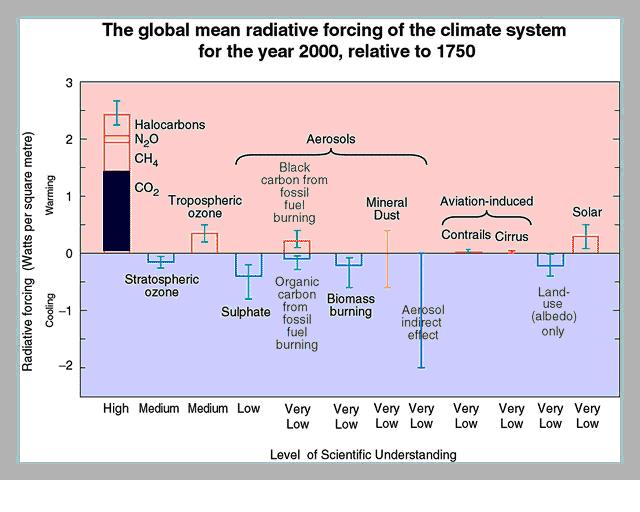The Radiative Balance
The total amount of forcing, think energy (a joule of a statement–I know) entering our planet from the sun is about 250 Watts per square meter of planetary surface. Of that 250 Watts per square meter (approximately, on average, disclaimer, disclaimer), 150 Watts per square meter (approximately, on average, disclaimer, disclaimer), is the retained energy part of our planet’s radiative balance (disclaimer, disclaimer). So, what about the other 100? It radiates back into space. This means the 250 IN from the sun (per square meter of Earth’s surface) and the 100 back OUT into space (per square meter of Earth’s surface) and the 150 that stays with the planet trapped by the atmosphere (as measured by watts per square meter of Earth’s surface) is our planet’s radiative balance with space (approximately, on average, disclaimer, disclaimer).
The term anthropogenic forcing of the radiative balance means we are monkeying with that naturally occurring radiative balance by bumping up the retained energy (adding to the 150 number) associated with Watts per square meter (W/m2) and lowering the 100 OUT number–also associated with Watts per square meter of planetary surface. GHGs created by human activity and the burning of fossil fuels are our methods of changing the radiative balance (no disclaimer here).
An additional view of this event: The naturally occurring greenhouse effect has warmed the Earth’s surface by approximately 34.25 degrees Celsius (disclaimer, Kelvin scale, disclaimer). Anthropogenic forcing of the radiative balance has increased that to 35 degrees Celsius. As the 150 number gets larger, the amount of retained energy (the planet’s average temperature) goes up. If the 150 number were smaller, the amount of retained energy (the planet’s average temperature) would go down (disclaimer, buffers, feedback loops, disclaimer).
The accepted (read conservative) influence of anthropogenic GHGs is projected to be an additional 2.5-8 degrees Celsius before the turn of the century. Or to put it another way, we can expect a 7% to 23% increase (disclaimer, black box, disclaimer) in impact from GHGs on the planet in less than ninety years–a lot less than ninety years (sorry, sorry). That’s darn quick for a change to a key planetary system.
Below–from http://www.esrl.noaa.gov/research/themes/forcing/ we can see the main items impacting the forcing.
Two items of note:
- Look at the size of the CO2 column vs. the other columns.
- The above chart represents the mean–that’s like an average (disclaimer, disclaimer), not the current amount of radiative forcing. Current forcing, which includes anthropogenic forcing, is a larger number.
Anthropogenic forcing of the radiative balance will add more than 3 Watts per square meter of forcing to the current forcing within the next fifty years–so minimally from 150 to 153 (approximately, on average, disclaimer, disclaimer). If you calculate the total surface area of the planet, using square meters (remember the planet is a curved surface), and then multiply that by the additional 3 Watts per square meter I think you will be impressed by the result. It’s a gosh-darn huge number. Also, as you might remember, heat is energy, and energy cannot be created or destroyed. So the added energy trapped by the planet has to go somewhere (dissipate).
Care to make a statement on where and how the retained energy will dissipate?
This is the dilemma science faces while trying to warn of the menace from anthropogenic forcing of the radiative balance. Scientists attempting to delineate the consequences try to quantify future events using a limited amount of resources (there is not enough computational power, raw data, or software for modeling) while suggesting good sense and appropriate risk management. A noble effort, all told. Those that attack the science–because the science is not precise about our future–even though climate science understands the trend are disingenuous (invective, invective).
And the kicker: At some point, the retained energy number (the 150 number) crosses a threshold (something above 150) and our climate goes non-linear, catawampus, chaotic, untidy, messy, dangerous, and highly destructive to human endeavors. Got any idea what that number is? That’s the key problem. No one else knows either. We just know an over energized climate system will happen at some point if we continue with our current policies (Chaos Theory).
Sorry, the comment form is closed at this time.